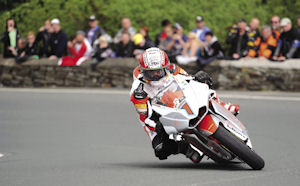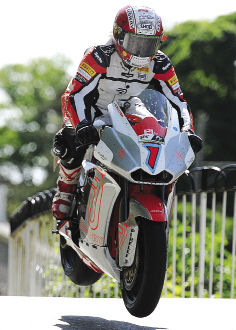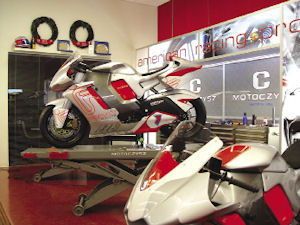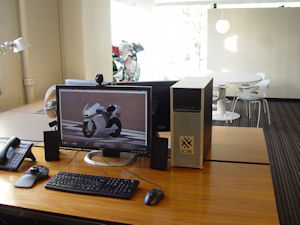Speedy Simulation Helps MotoCzysz Rule the Racetrack
BOXX Technologies helps this motorsport manufacturer take design to the next level in efficiency and aerodynamics.
Latest News
June 1, 2013
 MotoCzysz has won three first-place IOM races with its electric motorcycles. |
The Isle of Man (IOM) TT, located on the famed island in the Irish Sea, is home to the most difficult and dangerous motorcycle racetrack in the world. It is also where, for two weeks each year, motorsport manufacturers and riders alike come to prove that they belong among the motorcycling elite.
MotoCzysz has certainly earned its stripes in that arena. The Portland, OR-based design firm broke new ground in 2006 by moving away from gas-powered motorcycles to the new frontier of electric motorcycle racing. It has since grabbed three consecutive first-place victories in the IOM, among other titles.
The engineering team is at the core of the company’s success, and in addition to its reputation for building meticulously engineered machines, MotoCzysz designs and fabricates most of the components used in its motorcycles. Over the years, MotoCzysz designs have garnered attention from major vehicle manufacturers like Segway, which hired the firm to modernize the look and performance of its renowned personal transporter.
MotoCzysz’s latest endeavor is prepping the aerodynamic E1pc bike design for the IOM TT Zero 2013 (“zero” meaning “zero toxic/noxious emissions”) race slated for June 6.
“We do a redesign every year, but it doesn’t mean that every component changes,” notes MotoCzysz Senior Engineer Nick Schoeps. “Some years we do groundbreaking changes; this year, it’s all about optimization, seeing how we can further reduce weight, reduce inefficiencies, and optimize aerodynamics.”
MotoCzysz has a number of optimization targets in sight, including creating power efficiencies throughout the drivetrain, making sure electrical paths are as conductive as possible via shorter wiring runs, and eliminating friction spots on mechanical components. There is also work underway to simplify the suspension design via a reduced fastener count, as well as cutting back on the number of parts on the E1pc to make it simpler and more lightweight, Schoeps says.
Simulation-driven Design
Key to MotoCzysz’s design process is the ability to continually refine designs to create powerful and lightweight components. Yet as MotoCzysz began to take on more complex surfacing and simulation projects, it became clear that its existing workstations were taxed and additional GPU horsepower was in order.
The design firm’s overclocked, liquid-cooled 3960 XTREME systems from BOXX Technologies were state-of-the art when purchased in early 2011, but as a single GPU system relying on an older-generation NVIDIA Quadro card, the workstations could no longer support the team’s rendering requirements with optimal quality and performance.
 The company optimized its motorcycle this year to reduce weight and improve aerodynamics. |
With only six full-time employees and a limited budget, MotoCzysz had to carefully balance design decisions and cost concerns—all under the added burden of tight development and production schedules that began to dictate design decisions.
“With the older systems, we had to be pretty judicious about our resources,” Schoeps says, explaining that the system’s slow performance prevented engineers from rendering full designs at full quality, which often led to unwelcome design surprises.
A case in point: MotoCzysz engineers developed a new fairing design (the shell placed over the E1pc frame to reduce air drag, as well as to protect the rider and engine) only to discover upon production that the part included surface imperfections that required additional body fillers. Had the team been able to complete a more detailed rendering during the design process, they could have detected the imperfections and optimized the design prior to production. It would have saved time, money and—most importantly on the racetrack—unnecessary weight, Schoeps says.
Better BOXX, Better Bike
To cross the finish line first, Schoeps says MotoCzysz needed a solution that would reduce the requirement for expensive physical prototypes and move its workflow toward simulation-driven design. At the same time, the solution needed to be budget-friendly.
Capitalizing on longtime relationships with NVIDIA and BOXX, MotoCzysz was able to pilot a new generation of 3DBOXX workstations featuring NVIDIA’s Maximus technology, which combines the visualization and interactive design capability of its Quadro graphics cards with the computing power of NVIDIA Tesla GPUs into a single system. Tesla handles the photorealistic rendering or engineering simulation computation, freeing CPU resources to accomplish I/O, running the operating system, and other tasks, while the Quadro GPU is dedicated to powering interactive design.
The 3DBOXX 4920 XTREME, now the secret weapon in the E1pc bike’s redesign effort, features a 6-core Intel Core i7 processor overclocked to 4.75 GHz, liquid cooling and Intel solid state drives (SSDs). Critical to the system is the Maximus technology—a Quadro K5000 and a Tesla K20 built on NVIDIA’s Kepler GPU architecture.
“The 4920 XTREME with NVIDIA Maximus makes sense for us because we can create fully rendered images of a bike before we actually build it,” says Schoeps.
While larger bike manufacturers might create physical clay models to prove out their designs, MotoCzysz is limited in its ability to do so because of its smaller staff and budget, Schoeps says.
“We shot from the hip a bit with the older systems, because we didn’t always get the opportunity to do a rendering of the bike before making final parts, and sometimes we weren’t pleased with the results when we saw them in real life,” he says. “The new systems give us an edge in that space.”
Not only does MotoCzysz have the confidence that a design is correct on the first pass, but the new workflows enabled by the 3DBOXX 4920 XTREME and related technologies has resulted into a 20% to 30% time savings, according to Schoeps.
For example, with earlier workstation models, Schoeps’ team was forced to shut down a number of graphics features and simplify their models to make the rendering workflow more manageable. The Maximus-powered 4920 XTREME eliminates this obstacle, allowing the team to employ all graphics features and create physically accurate renders.
Multitasking with Design and Simulation
The 3DBOXX 4920 XTREME’s performance also translates into optimal performance for MotoCzysz’s array of core design tools, from SolidWorks CAD and Real View Graphics applications to Bunkspeed Pro, which the team is beginning to use for advanced rendering and analysis work. Now, Schoeps is able to multitask, creating a motion animation in SolidWorks while performing ray-traced renderings in the background with Bunkspeed Pro.
 |
“Bunkspeed’s performance on this system has been outstanding,” says Schoeps. “I can rotate the model, and it updates the design in real time. I can see how the different design features are interacting and how light is reflecting from different angles—all in a high-frame rate.”
Most importantly, the system allows Schoeps to concentrate on engineering, not on optimizing the workstation and worrying about properly configuring system resources.
“That’s what I like most about the BOXX,” he says. “It allows me to be a lazier engineer. I don’t have to think about the number of files I have open. I’ve had as many as 20 or more parts files open along with a large assembly and there are no problems, no lag in performance. It’s nice to have the freedom to think about the design and focus on the aspect of the project I’m working on, and not think about the machine.”
In addition to the Maximus technology and overclocked Intel Core i7 processors, Schoeps credits the inclusion of SSDs as another factor in the 4920 XTREME’s performance.
 MotoCzysz uses a 3DBOXX 4920 XTREME workstation equipped with a 6-core Intel Core i7 processor, overclocked to 4.75 GHz, and NVIDIA Maximus technology. |
“SSDs really require a cost/benefit analysis,” he says. “You pay a few hundred dollars more for SSDs , but how do you justify the cost of hiring another engineer? It makes economic sense to spend the money on the hardware that you rely on every day.”
While MotoCzysz manages to take on three to five additional projects per year, the design firm’s primary focus is still the E1pc—and winning races, especially the upcoming IOM TT Zero 2013. The improved performance throughout the design and rendering processes has enabled the engineering team to look at every aspect of the design from a fresh perspective.
“I’ve become the bottleneck in the system,” Schoeps admits. “There are only a certain number of parts we can design in a certain amount of time, and we can only spend a certain amount of time optimizing each one. The new system lets us do more optimization in the same amount of time. It gives us the time to make our designs better.”
John Vondrak is senior copywriter/video producer at BOXX Technologies. Additional reporting was provided by Beth Stackpole, contributing editor to Desktop Engineering. Send feedback on this article via [email protected].
More Information
Subscribe to our FREE magazine, FREE email newsletters or both!
Latest News
About the Author
DE’s editors contribute news and new product announcements to Digital Engineering.
Press releases may be sent to them via [email protected].






